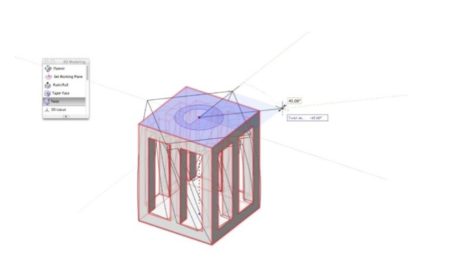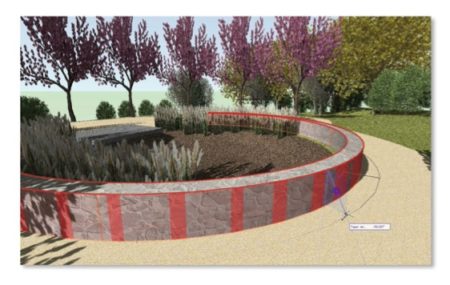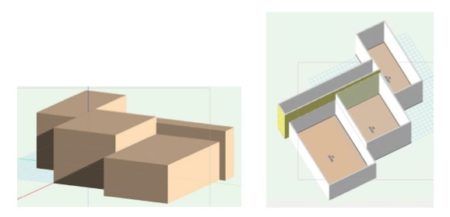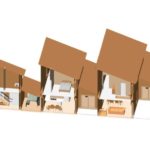Continued from page 1
Fast Interactive Display
This is cool. Make changes to your model and see them appear almost instantly. It’s a great way to try out various textures, colors, or even move walls, et cetera.
AutoCAD Compatibility Improvements
One of my biggest hangups has been the ongoing issue of working with other professionals that use programs with the DWG file format (like AutoCAD). So this year Vectorworks promises increased compatibility. What I really like here is the ability to bring in referenced DWG and DWF files without having to actually convert the original file.
Advertisement
This can be huge for several reasons. But the main one is that the original file can be modified by the outside professional and the changes he or she makes are then easily updated in the referenced file. Another thing is that when importing a DWG file the Vectorworks file can get cluttered up with a bunch of new classes which have little use in the Vectorworks way of doing things. That’s because AutoCAD uses layers for everything and they usually get converted to classes in Vectorworks.
I would normally import a DWG into a blank Vectorworks file then consolidate the classes into just a few, before importing that file into my working file. The problem here is that one can’t really export the revised original file back to whomever created it, without their file system being messed up. As one user told me DWG import-export is pretty good but it will never be good enough, probably because as fast as other programs update their compatibility those AutoCAD people change their program.
Section Viewport and ClipCube
You’ve been wining about the lack of good sections that can be created and updated when changes are made to the design. Now you have them, they can also be flattened placed on a drawing sheet annotated and then they automatically change when changes are made. This seems a very powerful tool and will take some getting used to. The sections can be made on sheet or on design layers. Section lines are added automatically and can be moved around in 2D or 3D views automatically changing the section. If you click on the section line and look at the object info another click can take you to the section viewport. (see images 02-04)
An interesting aspect to these new abilities is that in one Nemetschek Vectorworks 2014 movie showing the new feature they show the usefulness of how one can utilize two side-by-side viewports of a building, one in a 3D view and the other in a flat section view. With a change made in the 3D views a wall is pulled out and the flattened 2D section viewport right next to it gets updated on the fly. This, in a funny way, is the beauty of having more than one viewport in the user-interface to begin with, a limitation in the program that has been cited in the past.
Shaped Windows
Several new shapes appear in the window selections and 3D tags remain on the outside of the wall. Doors can have several glass panels inserted wherever one wants them.
Wall Tool Improvements
The big thing here is that when moving a wall it remains joined to other walls, it’s a small change but a time saver. Now you don’t have to go back and reconnect walls that get moved.
Roof Tool Improvements
Several changes here, but the one most interesting is the ability to use the clip tool to cut holes in the roof for placement of skylights, etc.
Eye Dropper Tool
In the past this seemed somewhat hit and miss, maybe I never really understood it, but now I find it very easy to use and I like how one can select from the tool bar to be in drop mode without holding down a key. Just select it and go around dropping in the features in the eyedropper. It is very handy for a lot of things, especially applying things like textures to walls.
Taper Face and Twist
These two seem like small changes, but they speak to something much more interesting. Vectorworks 2014 has become a real 3D design tool. One can really design using three dimensional shapes, build them, stretch, combine, subtract, twist, cut, and slope. (see images 05-06)

05 – new Twist model feature can be useful in a variety of scales within architectural applications.
There doesn’t seem to be a limit to what one can do in design, other than one’s design talent and ability to understand how best to use the features available in 3D modeling. According to some experienced users free form NURBS shaping is not up to speed in Vectorworks but better than what is available in ArchiCAD or Revit. I finally learned how to use the model to floor plan tool. It’s hidden in the space planning tools. (see image 07) It will convert most basic 3D objects to walls, so one can model with shapes only and then convert the shapes to a floor plan. If you have complicated twisted shapes, for example, you need to convert them to NURBS surfaces in pieces in order to create a form somewhat like a wall.

06 – The new Taper modeling feature is another welcome and useful tool in the landscape and architecture arenas.
The taper tool allows one to taper most any selected surface. Tapered walls are things that were once quite new in BIM programs in general and being able to see that you can do a tapered or battered wall in curved plan form is also completing Vectorworks’ abilities as a powerful design-oriented BIM tool.
Conceptual Models to BIM
Here we might talk a bit about what is Vectorworks really. Part of its problem, and at the same time its advantage, is that it’s not just dedicated to one design profession. It’s not just a program for architects. It’s kind of a universal design and rendering program. I like that because I don’t want to have to use 3 or 4 different programs to accomplish my work.

07 – New modeling parametric tools speed up architectural tasks from conceptual volumes to walls, floors and slabs.
It can be used for most any design project from a paste up poster for your kids school play to that high rise building project you’ve always dreamed of. But in being the one program for all it may lack some features that would make an architect’s work more automated.
Crop Imports
In the past if you imported a graphic, picture, etc. you had to crop it before the import or create a viewport and crop the viewport. Now you can simply crop the imported image in Vectorworks and just keep the part you want. That’s a nice change.
Publish Command
Well now you can select all the types of publishing you want to do all at once with one command. That is publish to the printer, PDF, and DWG all at the same time. It’s an interesting idea, I wonder how much use it will get. I think most people tend to do one or the other and not all at the same time.
What is Still Missing or on the Wish List
The stair tool seems to still be getting lots of complaints. DWG import-export is much improved but since it doesn’t produce native drawings in that format there will always be issues. Referencing them eliminates a lot of the issues there. Free form NURBS shaping is very useful and probably more than enough for architectural use, but for designers working mostly with NURBS there are better programs.
Also still missing are new methods for workgroups and team capabilities. While other BIM tools offer BIM servers and single-source, single-database methods to help large teams, remote teams and even remote offices manage larger projects, the gang at Vectorworks hasn’t done anything new in this area beyond its Vectorworks Cloud Services model. This can’t be just a reflection of the popularity of this application with smaller practitioners, as Vectorworks is massively popular in Japan where the company has several very larger customers–some with over 1000 seats of Vectorworks. As other BIM tools like ArchiCAD, Revit and Bentley advance their team work capabilities with brand new technology, I would hope to see the folks behind Vectorworks respond in like fashion.
Closing Comments and Recommendations
All in all Vectorworks 2014 has nice group of improvements. For anyone working in 3D and BIM the new OpenGL engine alone is probably worth the upgrade. Is Vectorworks Architect the CAD/BIM program for you? That depends. It is probably the most “CAD/BIM plus renderer” for the money on the market today. Some designers might prefer a more specialized and or simpler program. And some may just have to use a program like Revit that is more integrated with AutoCAD, which is still the de facto industry leader (by number) for a large portion of AEC users. The debate goes on, especially between Revit and its main adversaries like Vectorworks Architect.
One should also keep in mind that Vectorworks Architect 2014 is highly customizable–more so than what people commonly assume. So while out of the box it may not seem perfect–if spend some time setting up office standards, custom workspaces, template files, or even writing custom tools using the Python scripting language, it could become absolutely perfect for your needs.
Also have a look at my last year’s review of Vectorworks Architect 2013 here. You will find more useful insights into Vectorworks there. — JOHN HELM, NCARB
Pros: Brand new proprietary OpenGL rendering engine (Vectorworks Graphics Module) offers many new features, greater speed/performance; Improvements to interoperability, DWG file support now includes xref referencing without import; New Python scripting support; Improved BIM supports, new abilities in export to IFC and gbXML for energy calculations; compatible with latest versions of Windows and OS X (Maverick); software industry series versions address multiple markets beyond Architecture.
Cons: Still no major improvements in the workgroup or team capabilities; company apparently has no interest in integrated SE or MEP or energy modules, despite similar directions taken by rivals; no window-tiling options (one viewport only) despite excellent 3D NURBS-class level modeling power in the program.
Advice: The latest update includes the completely revised and rewritten OpenGL rendering engine, which is worth the cost of the update alone if you work extensively in 3D in any industry series version of Vectorworks and absolutely necessary if you work in BIM in Vectorworks Architect. Add the new dwg reference file feature, revised section viewports and the other 130 features and it becomes even easier. This is a big update. For the small office the ability to do so much with just one program adds intrinsic value to design, production, rendering and presentation workflows via simplification. For larger firms, limitations on teamwork or workgroup features means that larger organizations working on larger projects must figure out ways around these “larger scaled” workflow challenges
Cost: Vectorworks 2014 comes in several Industry Series versions. In this review I focused on Architect with the Renderworks package. This review does not review the other Industry Series solutions. Vectorworks Architect 2014 has an estimated retail of 2,595.USD and 3,335.USD for Renderworks package. The complete Vectorworks Designer with Renderworks package includes all other industries series together on one bundle for 3,945.USD.









Reader Comments
#CAD Product Review: Nemetschek Vectorworks Architect 2014 – In this feature review architect John Helm takes us t… http://t.co/niSK2GPLRh
#architosh | #BIM #Vectorworks Architect 2014 – The power of the ClipCube is discussed in our product review – http://t.co/cRf2mrreQv
Architosh http://t.co/62saxA90g7 via @sharethis – John Helm reviews #Vectorworks Architect 2014 for #architosh, commenting on best features
Architosh http://t.co/62saxA90g7 via @sharethis – John Helm reviews #Vectorworks Architect 2014 for #architosh, commenting on best features
#CAD Product Review: Nemetschek Vectorworks Architect 2014 – In this feature review architect John Helm takes us t… http://t.co/niSK2GPLRh
#architosh | #BIM #Vectorworks Architect 2014 – The power of the ClipCube is discussed in our product review – http://t.co/cRf2mrreQv
“@architosh: #Vectorworks Architect 2014 – The power of the ClipCube is discussed in our product review – http://t.co/tRs5C4LzvA” #spatial3
“@architosh: #Vectorworks Architect 2014 – The power of the ClipCube is discussed in our product review – http://t.co/tRs5C4LzvA” #spatial3
Product Review: Nemetschek Vectorworks Architect 2014 http://t.co/U8oLBvvA3j
RT @appleforarch: Product Review: Nemetschek Vectorworks Architect 2014 http://t.co/U8oLBvvA3j
Product Review: Nemetschek Vectorworks Architect 2014 http://t.co/U8oLBvvA3j
RT @appleforarch: Product Review: Nemetschek Vectorworks Architect 2014 http://t.co/U8oLBvvA3j
RT @architosh: John Helm has again provided a thorough review of Vectorworks Architect (version 2014) at Architosh. Numerous featur…http://…
RT @architosh: John Helm has again provided a thorough review of Vectorworks Architect (version 2014) at Architosh. Numerous featur…http://…
Comments are closed.